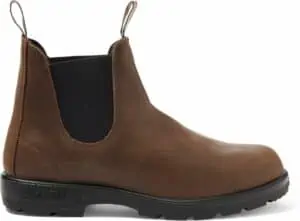Can Small Dogs Go Hiking? Things To Consider

We love taking our dogs with us hiking. There’s always at least one team member with a dog when we hit the trails.
We’ve had dogs of all sizes join us and you’re probably wondering if small dogs can go hiking.
The short answer is yes, but there are things you’ll need to consider.
We’ll outline some of the advantages (and disadvantages) of taking a small dog with you on your hiking trips, and more below.
Let’s dive in!

What Dog Is Considered A Small Dog?
Like many other pet owners, we also consider small dogs to be any breed that weighs 22lbs or less as full grown adults.
This covers a wide range of popular breeds such as the Chihuahua, Yorkshire Terrier, Pomeranian, Boston Terrier, and more.
Now that we’ve got that out of the way, let’s take a look at some things you should know about taking small dogs hiking.

Advantages Of Taking Small Dogs Hiking
There are actually quite a few advantages to taking small dogs hiking with you.
Easy To Carry
First and foremost, they’re easier to carry if your hike includes any scrambling or climbing.
Also, in case of emergencies where your dog can’t walk, you can carry them back to the car.
Ball of Energy
Another advantage of taking small dogs hiking is that they often have a lot of energy. This means they’re less likely to get bored and will be more likely to keep up with you on longer hikes.
Smaller dogs are less likely to get tired since they don’t have as much weight to lug around.
Plus, they tend to be more nimble on their feet, which can be helpful in avoiding obstacles.
Don’t Need To Bring A Lot of Food and Water
Because of their size, smaller dogs will always require less food and water than larger dogs.
Therefore, it’s easier to keep them well-fed and hydrated on the trail.
Disadvantages Of Taking Small Dogs Hiking
Of course, there are also some disadvantages to taking small dogs hiking.
More Predators
One of the biggest disadvantages of hiking with small dogs is that they’re more vulnerable to predators. Mother nature is brutal!
Coyotes, foxes, and even birds of prey can see small dogs as easy prey, so you’ll need to take extra care to keep them safe. We don’t advise having your small dog unleashed on a trail (and off the trail) for this reason.
Obedience
Studies have shown that there are behavioral differences between small dogs and large dogs.
Small dogs are less obedient and are more fearful of new surroundings, noise, and strangers.
As a result, it may be more difficult to teach them basic commands such as “sit” or “stay.” Regardless of size, having a strong recall is crucial when your pet ventures out a little too far for comfort.
More Prone To Injury
Finally, small dogs can be more prone to injuries on the trail.
This is because they’re not as strong as their larger counterparts and their bones are more fragile.
So, if you do take a small dog hiking, be sure to watch out for hazards such as sharp rocks or branches that could hurt them.
Body Temperature
Body temperature of small dogs fluctuates more rapidly than that of large dogs, making them more susceptible to both heatstroke and cold-related injuries.
This means you’ll need to be extra careful in hot or cold weather to make sure your small dog doesn’t overheat or get too cold.

Things To Consider Before You Go Hiking With Your Small Dog
Here are a few things to consider before you go hiking with your small dog:
1. Check The Weather
This is important for any hike, but it’s especially crucial if you’re hiking with a small dog.
As we mentioned before, small dogs are more susceptible to both heatstroke and cold-related injuries.
So, be sure to check the weather forecast before you head out and make sure the conditions are safe for your dog.
2. Bring A First Aid Kit
Again, this is important for any hike, but it’s especially important if you’re hiking with a small dog.
Because they’re more prone to injuries, it’s always a good idea to have a first aid kit on hand in case your dog gets hurt on the trail.
3. Keep Your Dog On A Leash
We cannot stress this enough! Small dogs are more vulnerable to predators, so it’s important to keep them on a leash at all times.
This will help you keep them safe and under control.
4. Bring Plenty of Food and Water
As we mentioned before, small dogs require less food and water than large dogs.
However, it’s still important to bring plenty of food and water for your dog on the hike. This will help them stay well-fed and hydrated throughout the day.
5. Watch Out For Hazards
Finally, be sure to watch out for hazards on the trail such as sharp rocks or branches that could hurt your small dog.
Avoid any trails with steep drop-offs or other hazardous conditions.
You should also consider the distance and elevation gain when selecting a hike.
Start with shorter trips and work your way up as your dog gets more fit.
By following these tips, you can help ensure a safe and enjoyable hike for both you and your furry friend.
Just remember to take things slow at first and always keep an eye on your furry friend.
See Also: 37 Best Tents For Camping With Dogs
Common FAQs
-
How far can small dogs walk?
This is a difficult question to answer as it depends on the individual dog’s health and age. Some small dogs may only be able to walk a few miles, while others may be able to walk much further. It is important to consult with your veterinarian before taking your dog on a long hike to ensure that they are healthy enough for the activity.
-
How often should I take my small dog hiking?
Again, this depends on the individual dog. Some dogs may be able to handle multiple hikes per week, while others may need more time to recover between hikes. Consult with your veterinarian to determine what is best for your dog.
-
How do you carry a small dog when backpacking?
When backpacking with a small dog, it is important to invest in a backpack that has adjustable and padded shoulder straps, as well as chest and waist straps. This will help distribute the weight of your dog evenly and prevent them from injuring your back. You should also make sure that the backpack is big enough to comfortably fit your dog.
-
How much hiking is too much for a dog?
This depends on the individual dog. Some dogs may be able to handle multiple miles of hiking, while others may only be able to handle a few miles. It is important to start with shorter hikes and gradually increase the distance as your dog gets more fit. You should also consult with your veterinarian before taking your dog on a long hike.
-
What are some signs that my dog is overheating?
Some signs that your dog is overheating include excessive panting, drooling, lethargy, and difficulty walking. If you notice any of these signs, it is important to stop hiking and find a cool place for your dog to rest. You should also offer them water to drink and wet their fur down with cool water. If your dog’s condition does not improve, it is important to seek medical attention.
-
Do dogs need shoes for hiking?
This all depends on the type of hike, trail difficulty, and weather conditions. Dog shoes or booties can be great if you’re hiking on a sunny day and the ground is hot. Shoes also protect your dog’s paws during long hikes and can shield their paw pads from thorns, rocks, sticks, and other pointy objects. Shoes also help reduce blistering and cracking.






